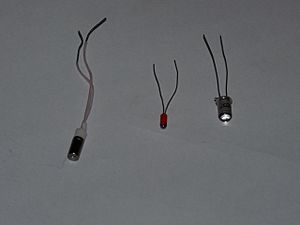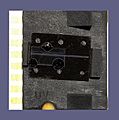Photodiode facts for kids
A photodiode is a special electronic part that can sense light. It's like a tiny light sensor! It belongs to a group of devices called semiconductors. A photodiode can turn light into an electric current or a voltage. This depends on how it's used.
Imagine connecting the two ends of a photodiode, called the anode and cathode, with a wire.
- If it's dark, no electricity flows.
- But when light shines on it, electricity starts to flow from the cathode to the anode.
The "diode" part of its name means it only lets electricity flow in one direction.
Photodiodes can come with special optical filters or even tiny lenses built in. They can also be big or small. Generally, a larger photodiode works a bit slower. A common solar cell, which makes electricity from sunlight, is actually a very large photodiode!
Contents
How Photodiodes Work
Photodiodes work using a special setup called a "reversed bias circuit." This means electricity is pushed in the opposite direction of how the diode normally wants to let it flow. When light hits the photodiode, it creates tiny particles of electricity (called electrons and holes). These particles are then pulled apart by the reversed bias, creating an electric current. The brighter the light, the more current flows.
Where Are Photodiodes Used?
Photodiodes are used in many everyday things. They are very useful because they can detect light and turn it into an electrical signal.
Light Sensors
Photodiodes are great at sensing light. They can tell if it's bright or dark.
- They are used in cameras to measure light levels.
- They help automatic doors open when someone approaches.
- They can be found in streetlights that turn on automatically at night.
Remote Controls
Have you ever used a TV remote? It uses a photodiode!
- The remote sends out invisible light signals (infrared light).
- The TV has a photodiode that receives these signals.
- This allows you to change channels or volume without touching the TV.
Optical Communication
Photodiodes are important for sending information using light.
- They are used in fiber optic cables.
- These cables send internet data very fast using light pulses.
- Photodiodes at the end of the cable turn the light back into electrical signals.
Medical Uses
In medicine, photodiodes help doctors in different ways.
- They are used in devices that measure how much oxygen is in your blood.
- They can also be found in some medical scanners.
Solar Cells
As mentioned, a solar cell is a type of photodiode.
- Solar cells are designed to capture as much sunlight as possible.
- They turn sunlight directly into electricity.
- This clean energy can power homes and even entire cities.
Images for kids
See also
 In Spanish: Fotodiodo para niños
In Spanish: Fotodiodo para niños





